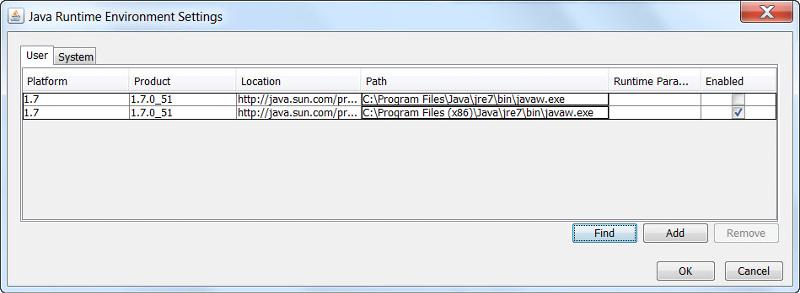How do I switch back and forth from JRE 32 bit and 64 bit versions
At one point I though I could switch between JREs by opening up the javacpl in 32bit and adding additional entries under the java tab see my screenshots
But that does not seem to work. Does anyone know how best to select each of these ?
Also the same question also regarding the JDK 7 update 51 s both 32bit an 64bit?
How to select In Eclipse if I specify the JRE as 64 bit does it use the JDK tools etc... from its respective 64bit install?

But that does not seem to work. Does anyone know how best to select each of these ?
Also the same question also regarding the JDK 7 update 51 s both 32bit an 64bit?
How to select In Eclipse if I specify the JRE as 64 bit does it use the JDK tools etc... from its respective 64bit install?

ASKER
Note that it appears there are in fact 2 javacpl.exe programs and data
when run from c:\program files(x86)\java\jre7\bin\j
and c:\program files\java\jre7\bin\javcpl
and they are different
but again which takes precedence and how is that determined?
when run from c:\program files(x86)\java\jre7\bin\j
and c:\program files\java\jre7\bin\javcpl
and they are different
but again which takes precedence and how is that determined?
Apologies if I've misread what you're asking.
Some applications require you to explicitly set the path to the Java components, that may be what you are referring to in your first question.
The installation packages include both 32 and 64 bit versions
Unless you are explicitly running Java within a 64 bit environment the 32bit version will run
eg even in a 64bit OS your borwser is likely to be 32bit and so the 32bit JRE will run within it.
Similarly a 64bit app will run 64bit JRE but a 32bit app in a 64bit environment will use 32bit JRE
You have the option to launch a 64bit version of IE in which case the 64bit JRE will be used.
As end-user you shouldn't need to switch between bit-versions, the most appropriate version should be called automatically.
Some applications require you to explicitly set the path to the Java components, that may be what you are referring to in your first question.
The installation packages include both 32 and 64 bit versions
Unless you are explicitly running Java within a 64 bit environment the 32bit version will run
eg even in a 64bit OS your borwser is likely to be 32bit and so the 32bit JRE will run within it.
Similarly a 64bit app will run 64bit JRE but a 32bit app in a 64bit environment will use 32bit JRE
You have the option to launch a 64bit version of IE in which case the 64bit JRE will be used.
As end-user you shouldn't need to switch between bit-versions, the most appropriate version should be called automatically.
In your own picture from the original question, what happens if you switch which one is "enabled" You may need to change both the user & system tabs plus reboot to effect the change.
ASKER CERTIFIED SOLUTION
membership
This solution is only available to members.
To access this solution, you must be a member of Experts Exchange.
ASKER
Giving me links was one thing but the trick really seems to be that
the path has to be put up front. I am a bit surprised since no mention of Java appeared in my path preceding it.
It seems that the of PATH makes this switch work actually, however, how this exactly works within a given browser seems somewhat hard to determine at runtime
Specifically because Microsoft IE 11 which used to come in two flavors when it was version 10
the 64bit version could easily be distinguished and one would imagine 64bit JREs would be invoked. I guess enabling the JavaConsole from javacpl.exe remains the only way to truly see which version is running
the path has to be put up front. I am a bit surprised since no mention of Java appeared in my path preceding it.
It seems that the of PATH makes this switch work actually, however, how this exactly works within a given browser seems somewhat hard to determine at runtime
Specifically because Microsoft IE 11 which used to come in two flavors when it was version 10
the 64bit version could easily be distinguished and one would imagine 64bit JREs would be invoked. I guess enabling the JavaConsole from javacpl.exe remains the only way to truly see which version is running
ASKER
C:\>java -version
java version "1.7.0_51"
Java(TM) SE Runtime Environment (build 1.7.0_51-b13)
Java HotSpot(TM) 64-Bit Server VM (build 24.51-b03, mixed mode)